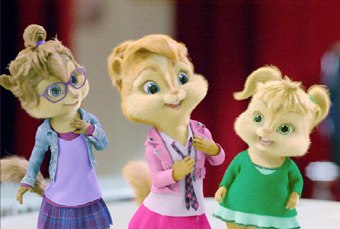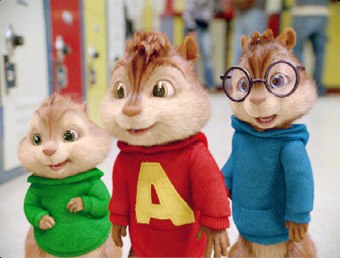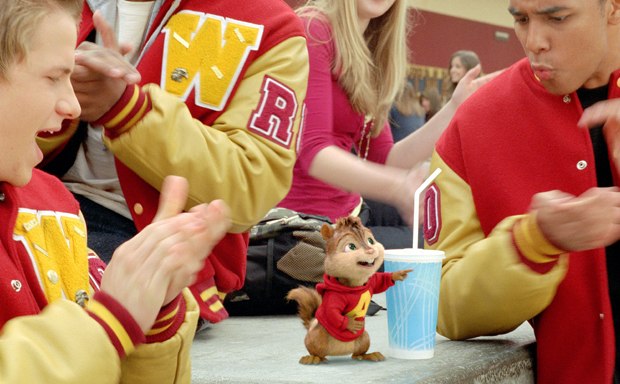Doug Smith discusses how Rhythm & Hues raised the chipmunk quotient for The Squeakquel.
Check out the Alvin and the Chipmunks: The Squeakquel trailers and clip at AWNtv!
The usual antics displayed in Alvin and the Chipmunks are nothing compared to what happens when the boys go to high school and the Chipettes are introduced as rock 'n' roll rivals in Alvin and the Chipmunks: The Squeakquel. Doug Smith, the visual effects supervisor, describes some of the challenges in Rhythm & Hues' largest production in 23 years, which has been shortlisted for a Best Animated Feature Oscar nomination (with more than 75% of the movie's shots containing animated characters). Rounding out the team is Chris Bailey (overall animation director); Andrew Arnett (senior animation supervisor); Keith Roberts (co-animation supervisor); Todd Shifflett (co-visual effects supervisor); and Michael Conelly (digital effects supervisor).
Bill Desowitz: What are the challenges of tackling Alvin?
Doug Smith: The first Alvin set the look for the characters and their behavior and it was a very difficult process. And I don't think people realize how tricky it is to take established 2D characters and turn them into three-dimensional shapes and bring them to life and maintain the personalities and nuances because there's a thousand issues to think about. And we budget a lot of time to make them dimensional and it's never enough. When you start putting them into shots and interacting with each other, it just changes your perception of how their shapes and how they behave. You have to keep reworking the characters, and the first Alvin had tremendous production schedule issues because that process went way into what was supposed to be the production schedule. Luckily, they were very successful at figuring that stuff out.
On the second one, we have additional characters -- these Chipettes, which were established in the cartoon series in the '80s-- but they actually look like little people and ours are little chipmunks that kind of mirror the guys. So that was also a long process, and the girls, in fact, take the technical issues further.
BD: How so?
DS: They have hairdos with hair that flops around and it had to be groomed a certain way. And there are a lot of aesthetics that go into somebody deciding what a hairdo looks like. And then clothing all had to be designed for them, and the Chipmunks all had clothing changes. And they had loose, floppy clothes on top of fur that also take it to another technical level when you're dealing with photorealistic characters, and the number of shots we had to deal with and there was more dance choreography on this one.
BD: What about the fur?
DS: There's a quality difference in the fur between the guys and the girls. The girls' fur is finer and softer, so it was a refinement of color and size, but a continuation of the process done with the guys. And Rhythm & Hues has a history of doing these fur creatures. They continue to use this process and there are a lot of tricks they have to do with millions and millions of hairs on these guys in order to make them economically feasible to get them through a pipeline that can render them and can deal with the lighting issues of shadowing and things like that.
But probably the thing that took [the longest] was the addition of hairdos on these Chipettes' heads to get naturally-looking combed hair. And the hairdos actually represent the personalities of the characters. So, I know it sounds funny, but everything you do with these characters represents their personalities, so, again, there's a lot of thought that goes into the clothing and hair. And by thought, it's iterations that we have to do. And it could be very subtle work and just important to the various creative people that see that it has to look natural and move naturally.
BD: What kind of advancements were there?
DS: There are different styles of hair simulations that have to be done and we've added some in exterior situations, where there's usually a light wind blowing on the characters and when their heads are moving around, there's just a variety of tech animation issues as far as the hair rebounding and the mass of the hair, the speeds of everything that need to be adjusted for different areas of the head. Then there are the collision aspects of hair going through hair, hair going through the costumes, hair going through props, hair going through eye glasses. It's a very complex issue for all parts of the creatures' heads. So it was very time consuming to take it to the next level with these girls.
BD: Any new wrinkles for the guys?
DS: The guys had more clothing changes. And there were some special situations: Simon ends up going into a toilet and coming back out and being completely wet, so there was some Houdini waters works that was done for that. There are not a lot of off-the-shelf packages that are used at Rhythm & Hues for major shows but Houdini is used a lot and Maya is used a lot for modeling.
BD: What about that nice FedEx bag entrance by the Chipettes?
DS: That was an interesting process in terms of rigging and animating the bag. On a larger show, where everything is compartmentalized, the back and forth that needs to be done for some of these processes gets pretty sophisticated, which is probably harder to appreciate on a more contained show where you have sort of generalists doing everything, handing the animation back and forth so you can get closer and closer to doing a successful simulation. And re-rigging this thing ongoing and dynamically while you're reanimating is also an iterative process. There were a lot of surprises for trying to get something that doesn't behave like cloth but is sort of a stiff-sided, bendable material packaging. And these characters tear holes in the bag, are contained within the bag, flopping around and pop out of it. And there's a certain process that I like to follow going back to the basic artwork and almost the look development of the packaging and find out how we diverge from reality -- and just having a group discussion about these differences. What the pieces are as far as the animation goes, and what it is about the shape and the lighting that is keeping us from getting closer to a real physical object.
We also had to deal with this cheese ball bag, where one of the characters is jumping on it. There are some subtle physics going on in the tension of the bags themselves.
BD: Harder than the cheese balls?
DS: Yeah, the cheese balls themselves are straightforward; the bag they go into turn out to be very tricky. There are some really specific things that happen and you hope that the solutions you use with cloth can work for a lot of different surfaces. They get you part way there and then you have to start finding other solutions to these shape issues that occur with deep folds yet flat surfaces that occur on these packages. And the kind of wrinkles you get are very easy to spot yet subtle and need a while to iron out all the problems.
BD: You must be pleased about getting short-listed for a Best Animated Feature Oscar nomination.
DS: Absolutely. CG work is still an undefined quantity and everyone is trying to figure out how it all fits together and how the traditional category names fit newer methodology. So, it is pleasing to see that and it just helps everybody to have it recognized for how much work goes into this kind of thing. And one of the issues with this film is that there are seven characters and close to 800 shots had to be done and when you get six furry characters with costumes singing in a lighting environment that is concert oriented, and you have a short schedule, it's a complex task with just background issues, like having a very robust pipeline to deal with many aspects of a shot changing simultaneously, and different versions of characters having to appear in different shots at different times.
Bill Desowitz is senior editor of AWN & VFXWorld.











